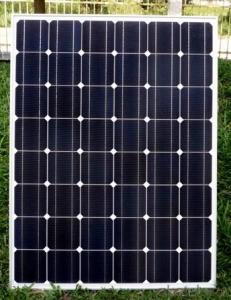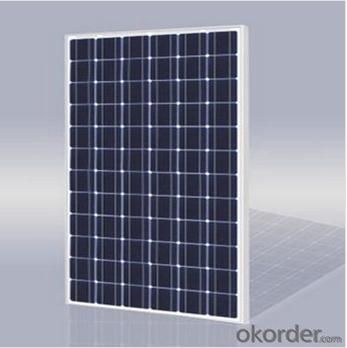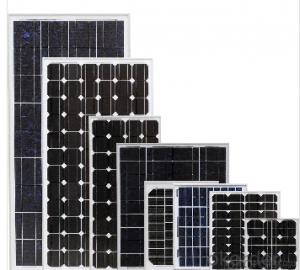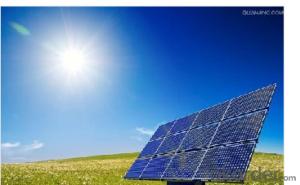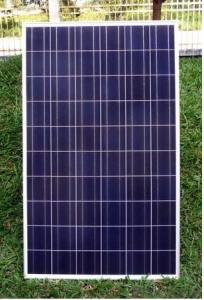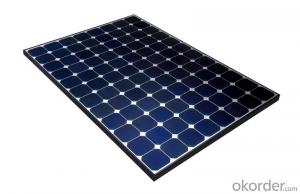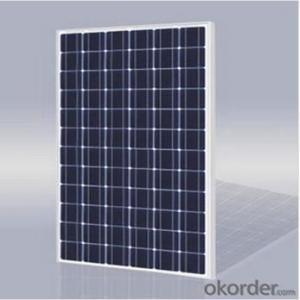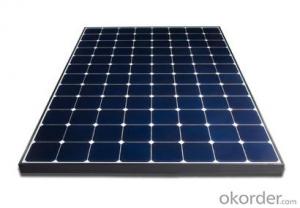Solar Panels Tallahassee:Multicrystalline Solar Panel 160W A Grade for Commercial
- Loading Port:
- China main port
- Payment Terms:
- TT OR LC
- Min Order Qty:
- 100 watt
- Supply Capability:
- 20000 watt/month
OKorder Service Pledge
OKorder Financial Service
You Might Also Like
Specification
Muticrystalline Solar Panel 155W A Grade For Commercial
Introduction
This is a kit using for factory and storage field. this product is a higher output version with stable power and we guarantee you for 20years.
A solar cell, or photovoltaic cell (in very early days also termed "solar battery"[1] – a denotation which nowadays has a totally different meaning, see here), is an electrical device that converts the energy of lightdirectly into electricity by the photovoltaic effect, which is a physical and chemical phenomenon.[2] It is a form of photoelectric cell, defined as a device whose electrical characteristics, such as current, voltage, or resistance, vary when exposed to light. Solar cells are the building blocks of photovoltaic modules, otherwise known as solar panels.
Solar cells are described as being photovoltaic irrespective of whether the source is sunlight or an artificial light. They are used as a photodetector (for example infrared detectors), detecting light or other electromagnetic radiation near the visible range, or measuring light intensity.
In contrast, a solar thermal collector supplies heat by absorbing sunlight, for the purpose of either direct heating or indirect electrical power generation from heat. A "photoelectrolytic cell" (photoelectrochemical cell), on the other hand, refers either to a type of photovoltaic cell (like that developed by Edmond Becquerel and modern dye-sensitized solar cells), or to a device that splits water directly into hydrogen and oxygen using only solar illumination.
Suggested application
Home lighting business lighting,
Garden lighting, pavement lighting
Farmer household lighting
Product feature
modules are made of Monocrystalline or Polycrystalline Silicon cell.
Materials and color of the solar panel frame: Clear anodized aluminum alloy type 6063T5 Universal frame; Silver-white color;
The output connection gathers the coupling: Selects conforms to the IEC-612615; 2005, class II, IEC61730 international standard; Airtight waterproofing binding clamp;
Module seal structure: The surface is thick, the high diaphanous rate armored glass with solar cell board special-purpose 3.2mm becomes after the high temperature lamination craft. The back selects has waterproof and anti- aged performance fine TPT materials. The entire block battery board has, the waterproofing, the anti- aging airtight and so on the fine performance;
Power tolerance: +/-3%
Packaging
International standard cartons(according to the requirements of customers )
- Q: Can solar panels be used to power a gas station?
- Yes, solar panels can be used to power a gas station. Solar energy can be harnessed through the panels and converted into electricity, which can then be used to power various operations and equipment at a gas station. This can help reduce reliance on traditional energy sources and lower the carbon footprint of the gas station.
- Q: Can solar panels be used in combination with wind turbines?
- Yes, solar panels can be used in combination with wind turbines. This combination of renewable energy sources allows for a more reliable and consistent power generation, as wind and sunlight are complementary in nature. By integrating solar panels and wind turbines, the system can generate electricity during both day and night, as well as in varying weather conditions, maximizing energy output and increasing overall efficiency.
- Q: I've found something called maximum system voltage 000v on my 0 w panel nameplate. Its impossible for 0w to have 000v, right?
- System voltage is the total across the full chain of panels, when using multiple panels in series. It's what the insulation on the panel is rated to stand, to earth/ground, without breaking down. A device could have an output rating of V and still a 000V insulation rating. eg. if your 0W panel had an open-circuit voltage of 25V, the insulation is rated to stand up to 40 panels connected in series. (40 x 25 = 000V). And actually a 0W power source could be rated at 000V, if it's current rating was only 0 milliamps. (Though extremely impractical for a solar panel unit).
- Q: Are solar panels affected by temperature?
- Yes, solar panels are affected by temperature. Higher temperatures can decrease the efficiency of solar panels, causing a decrease in their power output.
- Q: When you consider that solar panels will not produce enough electricity in their service life to cover their cost should we subsidize them anyway? that much of the cost of a solar panel is the energy to manufacture, install, transport and maintain them. Shouldn't the market determine whether they are worth installing?Is subsidizing them taking money away from research that could be spent on more viable alternatives?Should we be taxed to pay for others solar panels when they don't work?
- so, you think of that the perfect concept is to easily save specializing in oil and to not attempt to compete? each CON i've got talked to on right here is going on and on approximately how green power is a foul concept? yet, right this is China, with a centred purpose and fairly making it happen... ask your self how far we'd be interior the U. S. without the cons scuffling with us each step of how... how's that buggy whip enterprise going cons? that's what we recommend as quickly as we are saying owing to Republicans do you think of green power won't happen? China's already doing it... we are able to the two capture up, or supply up... and supply up has a huge unempmloyment value related to it...
- Q: How much space is needed to install solar panels?
- The amount of space needed to install solar panels varies depending on factors such as the size of the panels, the efficiency of the system, and the energy requirements of the property. On average, a typical residential solar panel system requires about 100-400 square feet of roof space per kilowatt of installed capacity. However, it's important to consult with a solar installer to determine the specific space requirements for your property.
- Q: How are solar panels installed?
- Solar panels are typically installed on rooftops or open ground areas. First, the area is assessed for its solar potential. Then, mounting structures are installed securely on the roof or ground. Next, solar panels are attached to these structures and wired together in a series or parallel configuration. Finally, the panels are connected to an inverter that converts the DC electricity generated by the panels into AC electricity for use in homes or businesses.
- Q: i need technical and non technical details to generate MW power by solar panels
- There okorder / Why pay thousands of dollars for solar energy ($27,000 average cost) when you can build your own solar panel system for just a fraction of the retail cost. You can build a single solar panel or you can build an entire array of panels to power your whole house. Some people are saving 50% on their power bill, some people are reducing their bill to nothing. But what’s most impressive is that just by following these instructions some are even making the power company pay them!
- Q: Can solar panels be used in areas with high levels of heatwaves?
- Yes, solar panels can be used in areas with high levels of heatwaves. In fact, solar panels often perform better in hot temperatures as they rely on sunlight, not heat, to generate electricity. However, it is important to ensure proper installation and maintenance to mitigate any potential heat-related issues and optimize their performance in such conditions.
- Q: How many solar panels do you need on your house to power your heater in winter?
- Your house, and probably your yard wouldn't be big enough to hold them. I did this exercise once (not doing it again) for someone who wanted to replace his 6hp outboard motor with a solar powered one. The calculations ended up that he would need something like .5 acres of solar panels to get that much energy. Not happening. That said, an passive solar home, can get a significant amount of warmth from the sun directly. But it doesn't work very well at night, when it's coldest. (wonder why that is... probably a climate scientist could help us with that? -- oh, wait. They say warming doesn't have anything to do with the sun.) Edit. I didn't use theoretical stuff to come up with my numbers, I used the claims of actual off-the-shelf solar panels sold by West Marine, calculated the power, and did the math based on existing panels.
Send your message to us
Solar Panels Tallahassee:Multicrystalline Solar Panel 160W A Grade for Commercial
- Loading Port:
- China main port
- Payment Terms:
- TT OR LC
- Min Order Qty:
- 100 watt
- Supply Capability:
- 20000 watt/month
OKorder Service Pledge
OKorder Financial Service
Similar products
Hot products
Hot Searches
Related keywords
